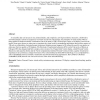Free Online Productivity Tools
i2Speak
i2Symbol
i2OCR
iTex2Img
iWeb2Print
iWeb2Shot
i2Type
iPdf2Split
iPdf2Merge
i2Bopomofo
i2Arabic
i2Style
i2Image
i2PDF
iLatex2Rtf
Sci2ools
FGCS
2006
2006
Personal Varrier: Autostereoscopic virtual reality display for distributed scientific visualization
As scientific data sets increase in size, dimensionality, and complexity, new high resolution, interactive, collaborative networked display systems are required to view them in real-time. Increasingly, the principles of virtual reality (VR) are being applied to modern scientific visualization. One of the tenets of VR is stereoscopic (stereo or 3d) display, however the need to wear stereo glasses or other gear to experience the virtual world is encumbering and hinders other positive aspects of VR such as collaboration. Autostereoscopic (autostereo) displays present imagery in 3d without the need to wear glasses or other gear, but few qualify as VR displays. The Electronic Visualization Laboratory (EVL) at the University of Illinois at Chicago (UIC) has designed and built a single-screen version of its 35-panel tiled Varrier display, called Personal Varrier. Based on a static parallax barrier and the Varrier computational method, Personal Varrier provides a quality 3d autostereo experie...
| Added | 12 Dec 2010 |
| Updated | 12 Dec 2010 |
| Type | Journal |
| Year | 2006 |
| Where | FGCS |
| Authors | Tom Peterka, Daniel J. Sandin, Jinghua Ge, Javier Girado, Robert Kooima, Jason Leigh, Andrew E. Johnson, Marcus Thiébaux, Thomas A. DeFanti |
Comments (0)

